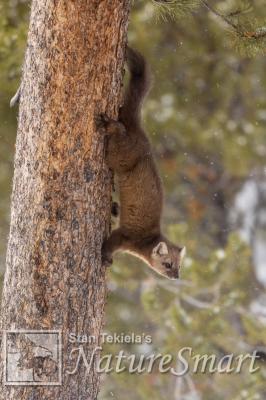View all of the titles in the
NatureSmart Bookstore

by Stan Tekiela
© NatureSmart
April 4, 2022
Having just returned from 3 weeks in Yellowstone leading photo tours/workshops, I am tempted to write more about the several encounters I had with the large charismatic predator, the Gray Wolf. However, this time I think I will write about a small, rather un-charismatic predator. A predator that is not often seen, yet every single day I would see countless tracks of this predator in the snow.
Each day I would spend hours and hours searching high and low looking for this elusive little predator. I could see its tracks leading from one tree to another. Hundreds and hundreds of tracks, both fresh and several days old. Then one day, we got a tip about a location that might allow us to see the half-pint predator, so we took off in search of the Pine Marten or otherwise called the American Marten (Martes americana).
Pine Martens are members of the Mustelidae (weasel) family and are directly related to other critters such as the badger, otter, ferret, mink, fisher and wolverine. It’s sometimes confused with the Fisher (Pekania pennanti) which is much larger and darker in color.
The American Marten is found in northern parts of North America but reaches down the Rocky Mountains in the western states. They are a species of conifer forests, often in rugged habitats with cold and snowy winters, so Yellowstone is a great place to see Pine Martens.
They are a long, slender-bodied weasel, that are slightly larger than a mink with a much bushier tail. They have short round ears that are gray to nearly white that stand out against their tan face. They have a long bushy tail similar to a squirrel and can climb trees nearly as well as squirrels. In fact, squirrels are one of their top menu items.
So, one morning we decided to search for the elusive Marten. Upon arrival in the general area, I went ahead to scout it out. I stood in the cold and snow looking for any movement and listening for any sound that might alert me to a Pine Marten. Thirty minutes later I gave up and went back to my photo group. No Marten today.
The following week I took my group back to the same area to take another look. This time several of the group came with me and we stood in the snow and cold waiting. Twenty minutes went by and nothing. Just about the time we were going to give up, someone in the group spotted the Pine Marten sticking its head out of the snow.
Everyone tried to capture some pictures as the small weasel ran from tree to tree then up into the higher branches and then sprang from tree to tree like a squirrel. We didn’t stand a chance to capture any images of this incredibly fast-moving critter. Then suddenly it was gone. No one saw where it went. It just disappeared. We looked and waited for a while and once again, we were giving up when someone spotted it about 100 feet away.
It was spotted near the top of another tree nearby. I moved down a narrow well-worn path in the snow hoping it might come my direction. As it moved to the bottom of the tree where the trunk doesn’t have any branches it came out in the open for just a split second. I lifted my camera and acquired focus and rattled off as many shots as I could before it dropped to the snow and was gone once again.
It was a very brief yet extremely thrilling moment, but a moment that resulted in just two of my images that are sharp enough and worth keeping. The sun was setting, and we had several hours ahead of us to get back to our lodging. Everyone was happy to see this small, lesser-known predator of Yellowstone National Park in the winter. Until next time…
Stan Tekiela is an author / naturalist and wildlife photographer who travels the U.S. to study and capture images of wildlife. He can be followed on Instagram.com, facebook.com, twitter.com. He can be contacted via his web page at www.naturesmart.com.
The nationally syndicated NatureSmart Column appears in over 25 cities spanning 7 states: Minnesota, Wisconsin, Michigan, Illinois, Ohio, New York and Pennsylvania. It is a bi-weekly column circulated to over 750,000 readers.
Wolves
Just the day before, a pack of wolves known as the Wapiti, had found a large bull bison that was weak and injured. Based on its size, this big boy was near the end of its lifespan and the winter weather was taking its toll. For a full day the wolves tried to approach the bison but when the bison...
Moose
It was one of those dark and cloudy winter days in Yellowstone National Park where the clouds are so heavy and low, you feel like you can reach up and touch the cloudy sky. A light wind helped to blow the falling snow with occasional gusts of wind causing swirls of fluffy white snow...
American Badger
It’s funny, I believe the average person knows more about the Honey Badger (Mellivora capensis), a critter of Africa and Southwest Asia than they do about the badger in our own backyard, the American Badger (Taxidea taxus). Social media has a lot to do with the Honey Badger phenomena and...
Backyard Bird Feeding
Winter bird feeding is one of the most common / popular hobbies in America. It is estimated that nearly 60 million Americans feed birds in their yards in winter or summer. That is about 40 percent of all American’s make backyard bird feeding part of their everyday activities. It’s...
Each year, during June and July, Stan Tekiela offers two world-class wildlife photography tours. Here's your chance to learn some tricks of the trade from a top professional.
View all of the titles in the
NatureSmart Bookstore
Check out Stan's latest photos at
NatureSmart Wildlife Images
Do you have any interesting wildlife in your backyard? Any nesting birds, deer, turkeys, reptiles, amphibians, or other unique wildlife? Or maybe a fox or coyote den?
If so, contact Stan at stan@naturesmart.com with your backyard wildlife. If he can get a good photo of the subject, he will send you a print of the photo to hang on your wall.
Order Prints and posters of Stan's photos at
» Prints & Posters
Hear Stan on radio stations all across the Midwest.
» More Info

When he's out in the field, Stan relies on his Vortex Razor binoculars and Vortex Razor spotting scope to help find the subjects for his award winning wildlife photography.

For thirty years, professional wildlife photographer Stan Tekiela has counted on Hunt's Photo and Video to provide him with professional photography equipment.
From tripods to camera bodies and lenses, Hunt's has been Stan's place for everything that he needs. Personal service and prompt shipping means Stan can count on Hunt's to support his professional wildlife photography career.


Professional Wildlife Photographer Stan Tekiela always uses Feeder Fresh in his seed feeders to help keep the feeders and food dry, clean and mold free.
He also uses Feeder Fresh Nectar Defender in all of his hummingbird feeders. It safely keeps nectar fresh longer.